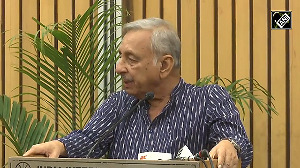Why has the drumstick tree not found favour with officialdom given the ease of cultivation, its excellent nutritional value, shelf-life of its leaves as food, and its use as vegetable, asks Sonali Ranade
South of the Vindhyas, you cannot get a helping of sambhar without the ubiquitous drumstick. For most Tamilians and Keralites, Moringa Oleifera (as the botanists call the vegetable) is what defines sambhar. Very few meals get done without the sumptuous vegetable making a presence in some form or the other. The vegetable's presence in most meals, in a largely vegetarian country, is no accident. Nutritionists confirm what your great-great-grand moms knew by sheer experimentation; that the humble drumstick is laden with the good stuff as no other food.
A well researched wiki entry along with references to the original papers, informs us of the nutritional value of drumsticks as compared with other common but more expensive foods:
Even when compared with the best in the class, Moringa leaves score higher in key nutrients by an order of magnitude. Mind, we are comparing just the leaves of the drumstick tree with other foods. The fruit scores just as high if not better. The advantage leaves have over the fruit is that they can be dried, powdered, and packed with a shelf life that exceeds three years without any diminution of nutritional value. Yes, it's a great opportunity, as big as Gaur gum, for some enterprising entrepreneur or MNC out there.
| Nutrients | Other Food | Quantity | In Moringa Leaves |
| Vitamin A | Carrot | 1.80 mg | 6.80 mg |
| Calcium | Milk | 120 mg | 440 mg |
| Potassium | Banana | 88 mg | 259 mg |
| Protein | Yoghurt | 3.1 g | 6.7 g |
| Vitamin C | Orange | 30 mg | 220 mg |
So why does this nutritious, nearly ubiquitous vegetable not figure in the diet of Indians in Northern India?
Matter of fact it does. The inspiration for this piece came from our maid who is visiting us after retiring to her home in a village in Chhattisgarh. She was with us for nearly 20 years. Her people are tribals. It still takes two days to reach her village from the nearest railway station. In the forests where she lives, the drumstick leaves are collected all round the year except in monsoon. The tender ones are cooked and eaten like spinach. The others are dried, powdered and used to flavor rice water [kanji]. The leaves give the kanji a hot, pungent taste besides their nutritional value. As she tells me, the leaves are the only vegetable they can get in the dry summer and they are eaten with relish. Must admit the kanji she made for me, with a dash of ginger and mint, was superb.
Moringa is an easy to grow plant that can be pruned regularly to keep its height within an arm's reach. It is best grown from cuttings, though seeds too can be used. The tree bears fruit within two years of planting and has a fruit bearing life of about 10 years. The best feature of the Moringa tree is that it grows in semi-arid conditions and doesn't need anything beyond a few showers every monsoon to survive. Therefore, it can be grown in the semi-arid regions of Gujarat and southern Rajasthan on any fallow land or even planted for forestry. It requires minimal care once to get to shrub size. It is excellent feed for cattle and so may require protection when planted but none after it attains a height of six feet or more.
Why has the tree not found favour with officialdom given the ease of cultivation, its excellent nutritional value, shelf-life of its leaves as food, and its use as vegetable?
I think it is a combination of the usual lack of familiarity, lethargy and inability to market successfully to a sceptical public.
The World Bank thinks very highly of Moringa as the solution to malnutrition in sub-tropics and semi-arid regions. It has an active research programme to study the tree and the ways to popularise its cultivation. So all that I have said here is not out of the blue. For an enterprising firm in the food business, the whole value chain, from supply of saplings/cuttings to farmers, gathering of fruit and leaves, processing and marketing as spinach or ingredient for spicy soup, is a huge opportunity. The fact that the tree can be grown cost-effectively in districts where nothing but inedible shrubs grow is a huge cost advantage. What it requires is education of potential farmers and marketing to get going.
Very little gets done in India without the politicians, with government babus in tow. The astute may have noted that I mentioned Rajasthan and Gujarat as two potential states that could benefit immensely from Moringa cultivation. There are others of course but I know only the semi-arid regions of Rajasthan and Gujarat first-hand. There are huge public benefits to Moringa cultivation in tackling the nutritional needs of the poor in a manner they can access the benefits without market intervention. It may be of interest to the governments of Gujarat and Rajasthan to actively promote Moringa cultivation through schemes for afforestation on wastelands under their care and through other promotional schemes including arranging for cuttings on the scale required from the southern states or other sub-tropical countries like Philippines.
The Central Arid Zone Research Institute, Jodhpur, is a federally sponsored research body doing some pretty nifty work in arid zone development. It can hardly be in ignorance of the potential for Moringa cultivation in the semi-arid zones that support large wild shrubs. So hopefully, the two state governments can be prodded enough to ask CAZRI to do a quick project in consultation with the World Bank to see if Moringa cultivation is feasible on a viable scale in southern Rajasthan and north-western Gujarat.
I have little doubt they scientists at CAZRI will not only be interested but excited at the prospect. Once the scientific validity of the proposition is established, the two governments should go all out promote the tree, its vegetables and leaves to the farmers and people of Gujarat and Rajasthan. The year 2014 is not far, there is time enough, and there are plenty of rural votes in such development schemes.
For us in the Konkan, the humble drumstick is a must-carry vegetable to Mumbai. On most Monday mornings you will find the sticks sticking out of bags of people catching the ferry from Mandwa to Gateway. The leaves and flowers, though, aren't eaten in Konkan. They can, and should be, turned into soup powder.
My maid bemoans the fact that much of the stuff that they traditionally eat in their forests is giving way to fancy "city vegetables" which are less nutritious and more expensive. Maybe CAZRI should take a look at Chhattisgarh and its tribal areas to see what other treasures they have discovered unknown to the rest of the world.
Or may be I am too sanguine that anybody in authority will take note of my plea in this article. In which case we might have to wait till some enterprising Chinese entrepreneur decides to retail La Mu or Lat Mok hot spicy soups as Chinese foods. The words mean "Spicy wood". Then our local patriots will rail against Chinese cultural invasion, bemoan the fact that we knew of drumsticks centuries before the Chinese, and that Chinese are simply taking unfair advantage in selling their soups to us.
All because we never paid any attention to our adivasis in the forests and their survival skills honed over centuries in the wilderness.












 © 2025
© 2025